List of Authors
>>About this blog
Recent blog post
|
[CAM]
January 31, 2016 18:00
 Yoshiume Yoshicho-tei Yoshiume Yoshicho-tei
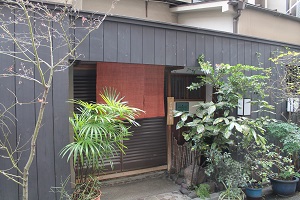 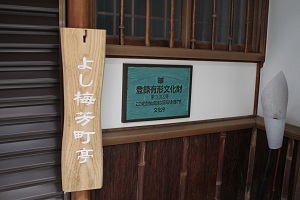 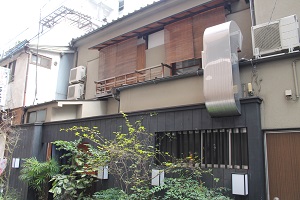
Before Showa / around 1927
2-story wooden building, tile roofing, building area 81m2
1 building
1-5-2, Nihonbashiningyocho, Chuo-ku, Tokyo
Date of registration: 20020821
It is a two-story wooden house built during the reconstruction period of the earthquake, with five girder lines and four and a half beams, gabled, and flat ground. The outer wall has been changed to mortar coating, but the interior uses high-quality materials for makeup, such as ceiling boards and board columns, and has a Sukiya-style design such as floors and basement windows, indicating the standard of Japanese style in the early Showa era. (From Cultural Heritage Online)
Edoya store and house
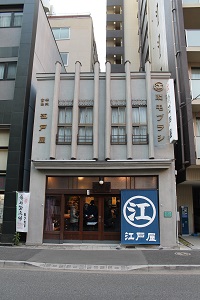 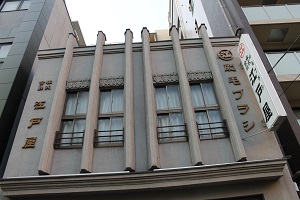 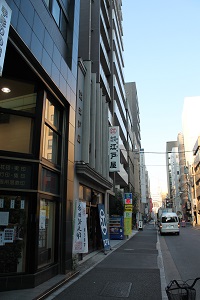 Taisho/1924 Taisho/1924
2-story wooden building, steel plate roof, building area of 94m2
1 building
1-5, Nihonbashiodenmacho, Chuo-ku, Tokyo
Date of registration: 20140425
A two-story wooden building facing the street, a so-called signboard building with an artificial stone washout finish. The front design represents a brush. The frontage is 6.2 meters deep, 19.6 meters deep. The first floor is a store, office, warehouse, and the second floor is a living room and warehouse. There are few renovations both inside and outside, and the fittings and safes remain original. (From Cultural Heritage Online)
Onoya Sohonten Store
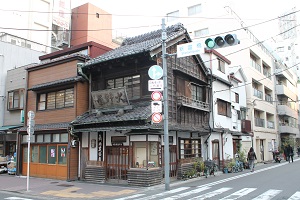 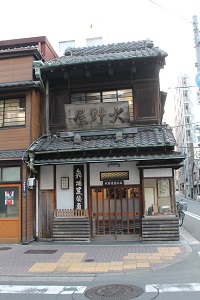 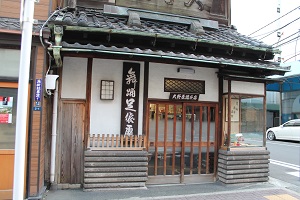
Taisho / Around 1924 / around 1955
2-story wooden building, tile roofing, building area 27m2
1 building
2-6-13, Shintomi, Chuo-ku, Tokyo
Date of registration: 20140425
It stands on the north side of the corner. It is a two-story wooden pantile roofing with a gabled roof. The first floor will be a store, and Tabi will be produced on the second floor. The upper and lower floors have high eaves, and the second floor is made of girder. The exterior wall is sashiko clapboard, and handrails are provided on the second floor window. One of the few prewar Machiya buildings in the area, built immediately after the earthquake. (From Cultural Heritage Online)
[CAM]
January 31, 2016 12:00
Hario Glass Building (HARIO Building)
 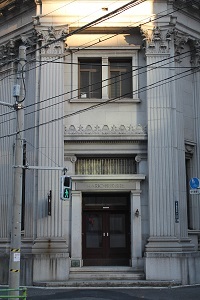 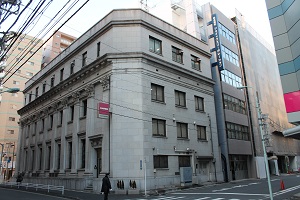 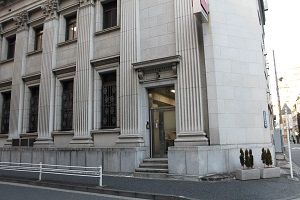
Before Showa / 1932
Date of registration: 20030701
Hario Tech Co., Ltd.
A sales room entrance will be set up at the corner cut at the northwest corner, and a colint-style large order with grooves on the north and west sides will be turned. This is a good example of bank branch building, designed by Kawasaki Saving Bank Building Division, and constructed by Takenaka Corporation. Currently, it is used as a head office building that also serves as a showroom for a heat-resistant glass tableware company. (From Cultural Heritage Online)
Bunjiro Tamaki Building
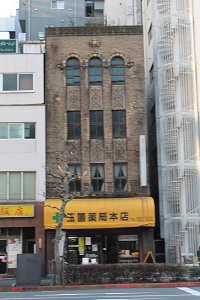 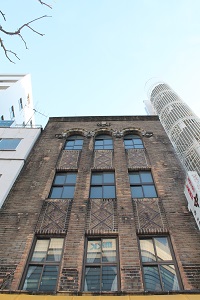 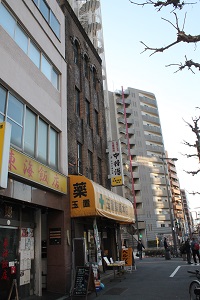
Before Showa / 1929
Reinforced concrete structure 4 floors above ground, 1 basement floor, building area 97m2
1 building
2-16-8, Higashinihonbashi, Chuo-ku, Tokyo
Date of registration: 20050209
A reinforced concrete store and house built north along Yasukuni Dori, four floors above ground, one basement floor, a chemical wholesale store and house. One of the commercial buildings after the earthquake, the appearance of incorporating geometric shapes into the decoration using muscle tiles and terracotta conveys the characteristics of architectural designs in the early Showa era. It was designed by Matsunosuke Moriyama.
(From Cultural Heritage Online)
[CAM]
January 30, 2016 18:00
Ryogokubashi
![IMG_2617[1]. jpg](https://en.tokuhain.chuo-kanko.or.jp/archive/IMG_2617%5B1%5D.jpg)
Explanation version of "Ryogoku Bridge, Ryogoku Hirokoji, Ryogoku River Opening"
![IMG_2616[1]. jpg](https://en.tokuhain.chuo-kanko.or.jp/archive/IMG_2616%5B1%5D.jpg)
Yagenbori Fudoin
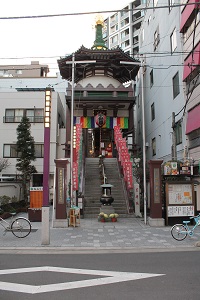
Tokyo Besin, Yagenbori Fudoin in Kawasakidaishi, has long been known as Edo San Ofudo along with Meguro and Mejiro, and has been introduced in many literature, including the Edo Famous Zoukai.
In 1137 (1137), the main deity (Acalanatha) was enshrined at Negoro-ji Temple in Kishu, where the 43-year-old unlucky year was reputed to be the ancestor of Shingon sect Chuko.
Later, in 1585 (1585), when the fire of Hideyoshi Toyotomi was hit by the fire, the Daiin monk capital of Negoro-ji Temple guarded the statue and put it in Tsuzura, carrying it on his back. I went all the way to the eastern country. Then, on the banks of the Sumida River, we set up a related spiritual site, and built Dou there. This is the beginning of the current Yagenbori Fudoin.
Later, in 1892 (1892), it became Tokyo Besin in Kawasakidaishi, and has continued to this day. It is also the place where Taizen Sato, who is said to be the founder of Juntendo, opened the Waran (Netherlands) Medical School in 1838 (1838).
Yagenbori Fudoin has a deep connection with each other, and since May 1982, the first dedication lecture "Kazutoyo Yamanouchi's Wife" by Professor Sadaka Ichiryusai has been held at fair on the 28th of every month. (From the Kawasakidaishi site)
The birthplace of Juntendo
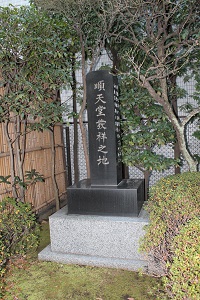
1838 (AD 1838)
Juntendo founder Taizen Sato In this area
Open a Japanese orchid Medical School
April 10, 1982
Juntendo School Corporation
Monument to commemorate the opening of the lecture
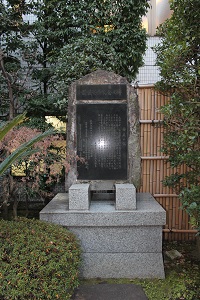 Description of Origin Description of Origin
A long time ago in the Genroku era, Akamatsu Seizaemon took Taiheiki at Tsuji, a town near Asakusa Mitsuke, and became the birthplace of Edo Kogaku. It later developed into the Taiheiki Koshakuba, which was popular with the common people for a long time, and the Taiheikiba Kigenno Monument was built during the Ansei period. This monument was later moved to the precincts of the Fudoin Temple and became a specialty until the 1923 Great Kanto Earthquake.
This time, due to the connection between the Fudoin and the Kodan Association, the memorial of the Shingon sect Soso Koho Daishi 11,150 years of anniversary, is a new monument here.
Daizo Masatakahashi Takatensensho
Kobo Daishi 1150 Anniversary Commemorative
Omotoyama Kawasakidaishi Hirama-ji Temple
Fall 1984
Tokyo Besin Yakuken Mining Fudoin
Kodan Association Tateyuki
The old city monument
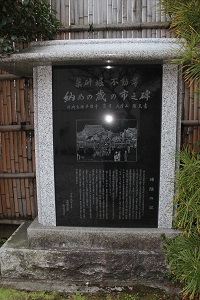 In the shadow of the monument In the shadow of the monument
From the middle of the Edo period, in the city of Edo in December, year old cities stood in various places.
Kadomatsu's Old Market is a city that sells New Year's goods such as the Kadomatsu Hoki rope decoration Hagoita and other New Year's goods. The old city of Tokyo began at Fukagawa Hachiman on December 15th and went around the Tenjin of Atago Jinja Shrine Hirakawa Yushima in Asakusa Kannon Kanda Myojin Shiba, and the end of the city was called Yafudoson.
At the time of the previous war, it was temporarily suspended with the spread of the war, and somehow revived after the war, but was deserted according to the times.
At last, in 1965, volunteers from the local town association store association should definitely leave the traditions of traditional event downtown since Edo to future generations, organized the Yagenbori fudoson Toshinoichi Preservation Society and at the same time co-sponsored with neighboring wholesale districts and sold clothing daily necessities at half the price of the market.
Also, if you think about it, the fact that you have consistently given the generous support of Kawasakidaishi Hirama-ji Temple, the Daihonzan of the main hospital, throughout the pre-war period, is a matter of note for reconstruction.
This year marks the 30th anniversary of the event of Odeko City together, so in memory of the ancestors who were passionate about the revival of the old city, this monument tells the way of passing this town to the old city to this day It is a proof.
April 15, 1996
fudoson Yagenbori
Toshinoichi Preservation Society
[Minori]
January 28, 2016 14:00
Hello, this is Minori.
This time, I went to Kachidoki.
At Kachidoki 4-chome, there are Toyo-in and Sumiyoshi-jinja Shirine, where the tombs of Tokasha 19 are located.
Toyo-in was famous as a Koin (Kiyomasa Kodo) in Zenryuji Temple in Zenryuji Temple, commonly known as Shinteramachi "Asakusa Permanent Town" (currently Moto-Asakusa 2-chome, Taito-ku), but was burned down in the Great Kanto Earthquake in 1923 (1923) It was relocated to its location as of May 1926 (1926). (By the way, Honji moved to Umeda 1-chome, Adachi-ku). He built a wooden main hall in 1927 (1927), a reinforced concrete charnel house in 1930 (1930), and a wooden warehouse in 1966 (1966).
The tomb of Jukasha 19 is located at the Toyoin Ossuary (indoor graveyard). The nineteen monuments "Tokasha 19 burial ground" (written by Musei Tokugawa) at the entrance of Toyo-in Temple were built by the Tokyo Film Company in February 1958 in the production of "Yaji Kita Dochuki". .
`` Tokaido Nakane Kurige '' is a story in which the main characters Yajirobei Tochimenya and Kitahachi travel on the Tokaido from Nihonbashi, and after Ise Sangu, take the form of a travel record that arrives in Kyoto. It became a masterpiece of 19. 19 died in 1831 (1832) and was buried in Toyoin.
Sumiyoshi-jinja Shirine is in the same Kachidoki 4-chome.
In resting place of portable shrines during the festival of Sumiyoshi-jinja Shirine, Tsukishima, Kachidoki and Harumi progressed, and as the shrine parishioner area expanded, resting place of portable shrines was established as a place of worship. It moved to Kachidoki 2-chome in 1930 (1930) and then to Kachidoki 4-chome in 1984 (1984). It's near Niijima Bridge.
If you exceed Asashio Kobashi (a bridge dedicated to bicycles and pedestrians, completed in March 2003 (2003), you can enjoy "Hot Plaza Harumi" (you can enjoy a heated pool and night view, outdoor jacuzzi, training area, and the latest machine) You can go out. In addition, if you walk straight along the same Harumi 5-chome toward the sea, you can also go to Harumi Wharf Park and Harumi Passenger Terminal.
<Reference>
[Tomb of Jukasha 19:
Bulletin board of Chuo-ku Board of Education
Supervision of "Chuo-ku Monoshiri Encyclopedia that can be seen on foot" Chuo-ku Tourism Certification Committee
Edited "Cultural Properties of Chuo-ku (4) Faith of Tangible Folk Cultural Properties", Social Education Division, Cultural Section
[Sumiyoshi-jinja Shirine]
Ieyasu 400 years Sumiyoshi Shrine Grand Festival Sumiyoshi Shrine, 370, 2nd land month Mutsumi
Sumiyoshi-jinja Shirine bulletin board (posted in resting place of portable shrines)
[CAM]
January 27, 2016 18:00
Ruins of Juzaburo Tsutaya "Koshodo"
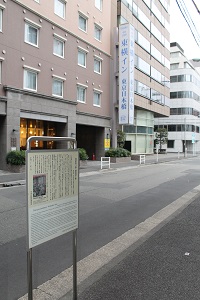
Juzaburo Tsutaya 1750-97 (Kanen 3-Kansei 9)
Tsutaya juzaburo
A representative publisher of the Edo period along with Suharaya Ichibei. It is commonly known as Tsutashige. Born in Edo Yoshiwara, he was adopted by Kitakawa. At first, he opened a shop on the Ikuma-michi outside Yoshiwara Daimon and sold Hosomi (Yukaku Guide), but in 1774 (Yasunaga 3) as a publisher for the first time, "Ichimoku Senbon Hanasumahi" (Shigemasa Kitao painting). After that, he set up a store in Aburamachi, Nihonbashi-dori, and played a part in the prosperity of the Edo publishing industry, against the backdrop of the so-called open world of the Tanuma era. The merchant was a sharp and spiky person, who had friends with many literary ink artists, players, and painters and took care of them. He collaborated with Nanpo Ota, Harumachi Koikawa, Kyoden Santo, and Makoto, and Ukiyo-e artists such as Shigemasa Kitao, Hoegata Tomosai, Utamaro Kitagawa, Katsushika Hokusai, Shakujii Toshusai, etc., and published a series of reputed works of the late Edo period Tensei. He was confiscated by the publication enforcement order accompanying the Kansei Reform, and half of his property was confiscated, but his rebellious spirit continued until he died.
(Hiroyuki Kano, Heibonsha World University Encyclopedia)
The ruins of the county mansion
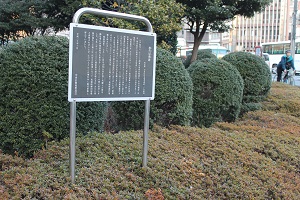
Location Near 2-chome, Nihonbashi Bakurocho, Chuo-ku
In the Edo era, there was a residence of the Kanto-gundai, which managed the collection of annual tribute, flood control, and the handling of territorial disputes in the territory under the direct control of the Shogunate (Tenryo) in various places, such as the entire Kanto area and the Tokai area. .
When Ieyasu Tokugawa entered the Kanto region, Tadatsugu Ina was appointed as Deputy Chief, and later became known as Kanto-gundai, and Ina was inherited for twelve generations. The residence was initially located in the Tokiwa Bridge gate of Edo Castle, but was burned down by the great fire of the Meiryaku era (1657) and moved to this area.
After 1792 (1792), when Tadataka Ina gained guilty and lost his leg, the magistrate of the account lived here as the Kanto county.
After being burned down in 1806 (1806), it became a deputy and was renamed Bakurocho Imperial House, but the people of Edo have long called this land a Gundai mansion.
March, 1994
Chuo-ku Board of Education
Ryogoku Hirokoji Monument
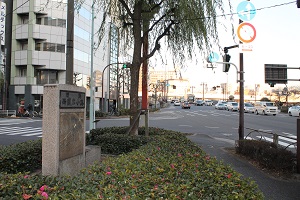 The great fire of the Meiryaku era (1657) destroyed most of the city of Edo and killed more than 100,000 people. At that time, the Sumida River, where Ryogoku Bridge was built in the Meiji town, which was built in 1000 years ago, was built in 100 years ago in the town of Hirokoji, which was built in 1000 years ago, the historic town of Hirokoji and the historical sites of Hirokoji, which was built here as one of the three historic sites of Edo's Three Great Hirokoji Temple and built here. The great fire of the Meiryaku era (1657) destroyed most of the city of Edo and killed more than 100,000 people. At that time, the Sumida River, where Ryogoku Bridge was built in the Meiji town, which was built in 1000 years ago, was built in 100 years ago in the town of Hirokoji, which was built in 1000 years ago, the historic town of Hirokoji and the historical sites of Hirokoji, which was built here as one of the three historic sites of Edo's Three Great Hirokoji Temple and built here.
November 3, 1969
Monument to the Nihonbashi Ryogoku Neighborhood Association in Chuo-ku
Yanagibashi
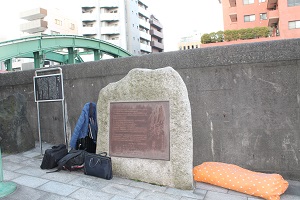
Location 2, Higashinihonbashi, Chuo-ku
1-chome Yanagibashi, Taito-ku (Kanda River)
Yanagibashi is the first bridge located at the estuary where the Kanda River flows into the Sumida River. Its origin was in the middle of the Edo period. At that time, Shimo-Yanagihara Doho-cho (Chuo-ku) and Shimoheiemon-cho (Taito-ku) on the opposite bank came by boat, but it was inconvenient and was approved in 1697 (1697) by requesting a bridge over Minamicho magistrate's office, and was completed in the following year.
At that time, there were many inns for boaters on the Sumida River around Yanagibashi, and it was bustling as seen in Kawayanagi saying, "Surve a gamma into the Yanagibashi River."
It became a steel bridge in 1887 (1887), and Yanagibashi fell in the Great Kanto Earthquake of 1923 (1923). The Reconstruction Bureau is devising the design of the first bridge at the mouth of the tributary to change the design of the boatman's return to the port. Yanagibashi incorporates the design of Eitai Bridge, referring to the bridge of the Rhine River in Germany, and was completed in 1929 (1929).
Seventy years after its completion, the number of reconstruction bridges is now decreasing in the ward, and Yanagibashi was developed as a valuable modern civil engineering heritage in 1991, and was registered in the ward Tangible Cultural Property in the same year.
March, 2002
Chuo-ku Board of Education
[CAM]
January 27, 2016 12:00
Bronze bell at the time of Kokumachi
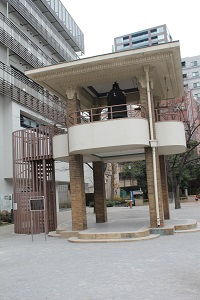
It is the bell when the people of Edo Castle were notified of the time. It is said that the bell of time was installed in Honishicho 3-chome (currently Nihonbashi Muromachi 4-chome) during the second generation Hidetada era (1605-1623). This bell was recasted in 1711 (1711) and was used until the early Meiji era, and moved to its current location in 1930 (1930).
Chuo-ku Board of Education
Bell at Ishitoki Town Hoei Era Time Bell
Designation No. 4
One of the bells of Kokumachi
Location Nihonbashikodenmacho, Chuo-ku Owners Chuo-ku, Tokyo Office
Bronze bell height 1.7 U.S. diameter 93 centimeters Shigehisa Hoei, April, name Iyo Fujiwara Shigekyu
The right is designated as a treasure.
November 3, 1953 Tokyo Metropolitan Board of Education
It was the first bell at the time of the Edo period, and at the time of the second shogun Hidetada, it was in the west circle of Edo Castle, but since the bell tower was damaged near Goza, the bell was built in Nihonbashi Kokumachi in 1657 and 1679, 1666, and 1679. The sound is said to be the sound of a long time. In 1725, a bell tower was built on the land of the new road on the north side of the former Honishi-cho 3-chome. It was collected and maintained from a total of 400 towns in Omachi Komachi Yokomachi, a commercial district. The role of the bell was also called Tsuji Bell because Genchichi Tsuji had been playing for generations from the beginning. Under the bell tower, the poet Kabumura held a haiku party under the name of the night half-tei, and was famous along with Basho-an in Fukagawa. At that time, Edo had time bells at nine locations in Nihonbashi Kokumachi, Asakusa, Honjo, Yokogawa-cho, Ueno Shibagiri-dori, Ichigaya Yahata, Meguro Fudo, Akasaka-cho, Yotsuya Tenryu-ji Temple, but Kokumachi Toki Bell is the oldest. It is. Temmacho Hell was located about two streets from Kokumachi Belfry Hall. The prisoners may have heard the sound of this bell with various thoughts, and the execution was also executed with the sound of this bell as a signal, but it was sent as if praying for the life of the prisoner. It is also reported that it is a bell of compassion. After the abolition of the late Tokugawa shogunate Toki Bell, it was the treasure of the Matsuzawa family of Kokumachi, but in September 1930, the Jushi Support Association was donated, and in September 1930, the Hoei era Toki Bell Tower was built in Jisshi Park, and the mayor of the time, Hidejiro Nagata, donated to Tokyo.
Daianrakuji Temple
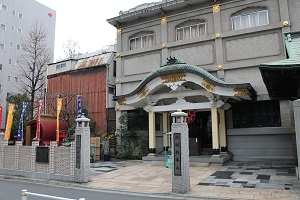
The ruins of Temmacho prison mansion
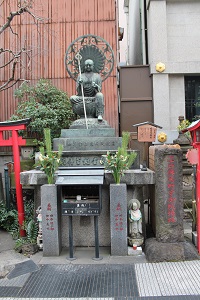
Ruins of Temmacho prison site
Location Fifth Avenue, Nihonbashi Kodenmacho, Chuo-ku
Designated November 3, 1954
The prison in Edo moved from outside Tokiwa Bridge to Kodemmacho during the Keicho era (1596-1615). The large number of Ishido swords have been appointed and managed for generations. And it survived until May 1875 (1875).
According to the records of "Remarks in Gofu", it can be seen that the scale was vast. In other words, the area was 2,618 tsubo (8639.4 square meters), and the four sides of the site were covered by moats. There was a front gate in the southwest. The prison building was divided into a parlor, a prison, a prison, and a female prison room. In 1657 (1657), there were Yoshida Shoin and more than 90 people.
Construction on October 1, 1969
Tokyo Metropolitan Board of Education
The ruins of Edo Temmacho prison mansion
No. 29 of History
The ruins of Temmacho prison mansion
Location Five destinations of Nihonbashi Kodenmacho, Chuo-ku Owner Tokyo (managed by Chuo-ku)
Land area 13.45 tsubo (22 shaku square)
The right is designated as a historical site.
November 3, 1954 Tokyo Metropolitan Board of Education
Temmacho prison moved from the area of Tokiwa Bridge during the Keicho era and lasted for about 270 years until Ichigaya prison was established in 1875, and during this time hundreds of thousands of people were sent from all over the country as Edo Temmacho prison sending. It is said to have counted. The area including the current Daianrakuji Temple, Minobubetsu-in Temple, Muraunbetsu-in Temple, Jushi Elementary School, and Jisshi Park is the site of the Temmacho prison. At that time, there were main gate in the southwestern part and an unclean gate in the northeastern part. The prison was divided into a lifted parlor, a lifter, a large prison, a peasant prison, and a female prison. The lifter was Buddhist monk, the large prison was a commoner, the peasant was a peasant, and the female prison was only a woman. There is a guardian of children and travelers at the time, which is said to be the death sentence place at the time of the precincts of Daianrakuji Temple, and the casting amount of Tesshu Yamaoka's brush states that "the prisoner's death group is separated." The role of the prison is in the rugged head, the large lord Ishide sword, the Go □(Thu + Jiang) The role of the death penalty was the famous Asaemon Yamada, 78 concentrics, 46 prisons, and it was said that he went around the prison on a monthly basis from the north-south Ryomachi magistrate. The period of one year and three months from September 1858 to December 2006, when the unprecedented turmoil was presented as Temmacho prison, i.e., Yoshida Shoin, Sanai Hashimoto, Yorizosaburo, etc. were sent to prison in Ansei's prison, and most of them were killed. It is said that those who have shed precious blood since then have reached 96 people together with the former. When he heard the sound of the bell of Kokumachi, he would have been prepared many times, saying, "It is the news of my last time." In the precincts of Shomura Unbetsuin, there is a shrine and a wooden monument of 96 members of the royal priest.
November, 1954
Edo Historic Site Preservation Sponsorship Association
Kiya Katsusaburo successive monuments
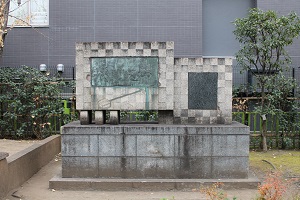
The end of Dr. Shoin
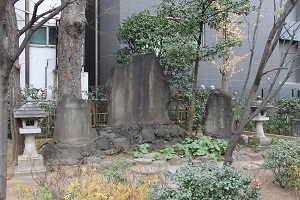
(Back side)
Eastern foot of Hagi Castle Ruins
From the vicinity of Hachimangu Shrine Miyazaki
The stone to be dug out
Donation of volunteers from Hagi City
stone monument
The body does not decay in Nobe of Musashi.
The Yamato Soul
The end of Dr. Shoin Yoshida
Dr. Shouin Yoshida was born on August 4, 1830 (C.E. 1830) as the second son of the Sugi family in Matsumoto Village, the eastern suburbs of Hagi, Choshu. I joined the Yoshida family when I was young. The name of an adult is called Tora Jiro. Since the Yoshida family was the home of the Yamaga-ryu military teacher for generations, he was a great man who studied Yamaga-ryu military science and other studies from an early age, studied the path, and worked to educate his children. In March 1854, he planned to travel abroad with the recommendation of his teacher, Shozan Sakuma, failed to get on a U.S. ship from Shimoda, and was connected to Shimoda's prison, but was sent to Temmacho prison on the way, Takanawa Sengakuji It is the famous next song that I wrote in front of the famous song. "I can't help but know that it's going to be hide, Yamato soul." Education at Matsushitamura Juku will be the greatest business. Among the many prominent men, including six barons, seventeen gifters, and fourteen rankers, among others, Ito Hirobumi, Aritomo Yamagata, and Takayoshi Kido, among others, were successful in the Meiji Restoration. The three major changes in the history of Japan are the renewal of Dahua, the establishment of the Kamakura shogunate, and the Meiji Restoration. Goshoin was tied to Ansei's prison and was once again prison in Temmacho. On July 9, 1859, he was first called to the rating office from the Choshu clan residence in Edo, but at that time he wrote in his song, "When I get a town, it's a snug that sounds very good now." . However, he was unable to move the officials of the Shogunate, and on October 22, when he was prepared to pay the death penalty in three subsequent investigations, he sent a book of perpetuence to his father, uncle, and brother. Is one of the heads of the parents who are more than the hearts of their parents." Also, knowing that the time of execution was approaching, I wrote it from October 5th to the twilight of Hatsetsu 6th in the romary record at the beginning of the statement, `` The body is decayed in Nobe of Hitake Sashi. It is said that the Yamato soul is 21 times on October 5th. Shoin sent this prisoner to Yoshigoro Numazaki, who became an island in Hachijojima Island, but handed it to Yasushi Nomura, a junior student at the Kanagawa Prefectural Ordinance at the time, twenty years later. As a result, the court at that time and the response to the inquiry, the news of the prisoners were understood, and it was a sublime book of Shoin soul that showed his own feelings and the way the students should go. It is. October 27, 1859, was the day of execution. Shoin, who left the lifter, scolded the following poems with a high spirit and told the prisoner a trick. In the prison, he recited the song of "Tatatohi" and was sentenced to obey him as a servant. On February 11, 1983, Meiji 30 years old, was awarded the fourth place on February 11, 1964, and a monument was built in the yard of the Jushi Elementary School.
|
Links
|
![]() Yoshiume Yoshicho-tei
Yoshiume Yoshicho-teiTaisho/1924
![IMG_2617[1]. jpg](https://en.tokuhain.chuo-kanko.or.jp/archive/IMG_2617%5B1%5D.jpg)
![IMG_2616[1]. jpg](https://en.tokuhain.chuo-kanko.or.jp/archive/IMG_2616%5B1%5D.jpg)

